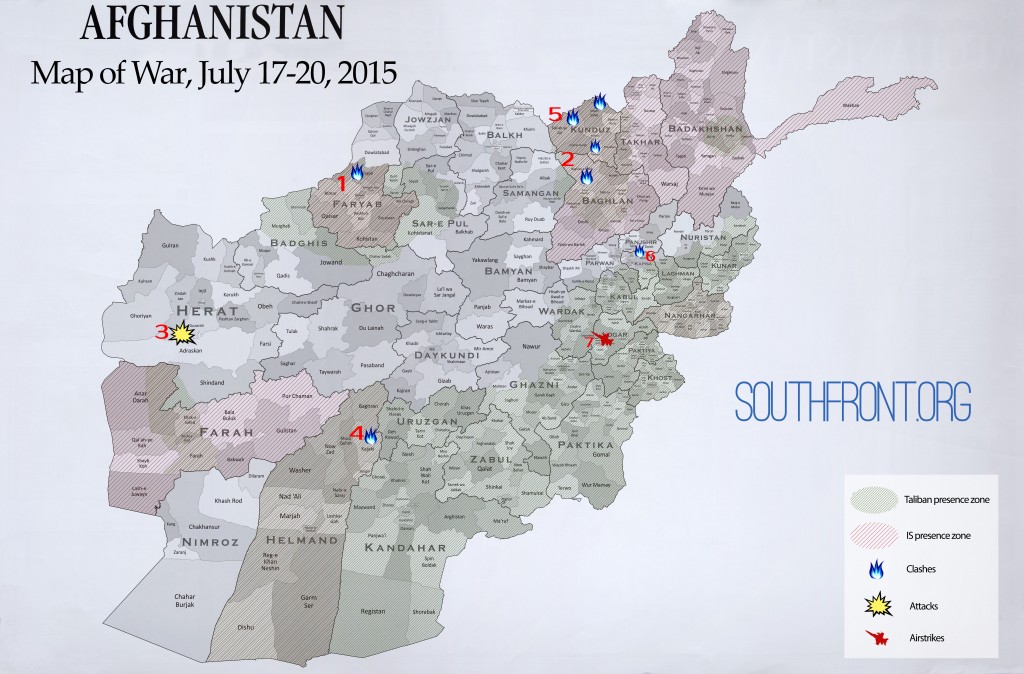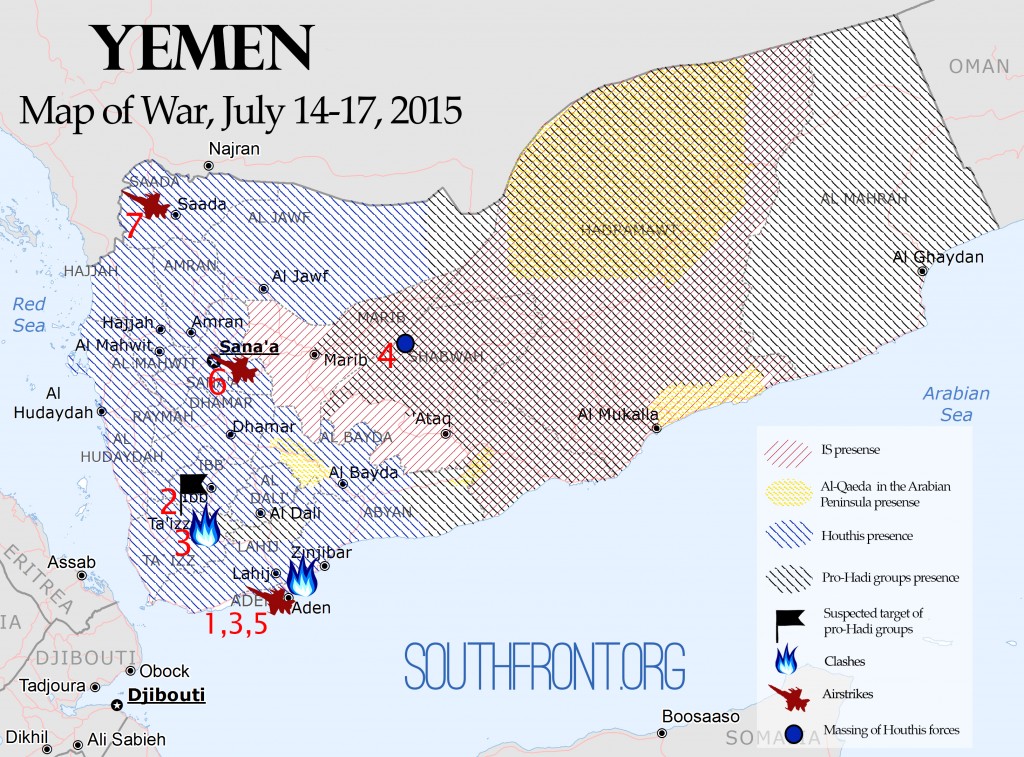- July 17, The situation in the northern Afghan Faryab province that borders Turkmenistan is critical. Militants began attacking the province in early July, they have seized more than 100 villages in little over a week. Local pro-government forces called People's Resistance Front are retreating in almost all areas of Faryab. The provincial capital, Maymana, is in danger of falling into the hands of the Taliban. The chief of the Faryab Provincial Council said "It's a desperate situation" and blamed lack of support from the central government.
- July 17, The Taliban started an offensive in the Baghlan-e-Jadid district of the Baghlan province. Militants reported that they overran five military installations and cleared a huge area. There is no information about causalities, however, the Taliban suggested that a number of pro-government soldiers were killed or wounded.
- July 18, 6 policemen were killed and 3 were injured as result of a bombing in the Herat province. The incident occurred when policemen were patrolling the Guzarah district because of the Eid al-Fitr celebration. Eid al-Fitr is an important religious holiday celebrated by Muslims worldwide that marks the end of Ramadan. Local administration believes that the attack came from the Taliban. However, no anti-Government groups took responsibility for the violence.
- July 18, The Taliban claims it overran an Afghan military base and paraded troops through the bazaar in Kajaki, northern Helmand province. The terrorist group made the claim in a video produced by Al Emarah and released on Voice of Jihad, its official media outlet. The video "Azm Operations in Helmand Province, Graveyard of the British Empire," shows a suicide bombing on an Afghan military checkpoint and a mortar attack on the base in the southern Afghan province. The video also highlights US-made Humvees used by the Taliban. They also claimed to have taken large portions of Kajaki. The video shows images of militants in the district, including Kajaki's bazaar.
- The clashes in Helmand are part of the Taliban's Azm offensive, which began earlier this year. Most of the fights have taken place in the northern Afghan province of Kunduz since end of the April. The districts of Imam Sahib, Aliabad, and Qala-i-Zal are under constant attack. Their current status is unclear, but it's likely that the Taliban controls Imam Sahib and Aliabad. The Helmand provincial council reported the Kajaki district will be completely under Taliban control if the military does not launch a counter-attack.
- July 19, Afghan government forces launched an anti-terrorist operation in the Kapisa province. During the operation 2 militants were killed and 6 were detained. The operation took place in the Nijrab district. There is no information on which terrorist network the militants belonged to.
- July 20, The US Air Force bombed a checkpoint of the Afghan National Army in the Baraki Barak of the Logar province instead of Taliban positions. In the airstrike 8 servicemen were killed, 5 were injured. Afghan authorities report that the air raid wasn't coordinated with the Afghan government.
It's important to divide the Taliban's presence, governance and attack zones.
- Presence zone: an area where Taliban is able to move freely (conduct offensives on isolated Afghan government-controlled points), exert physical pressure to assure that individuals/groups responds as directed.
- Governance zone: an area with direct Taliban governance (unclear even for Afghanistan authorities).
- Attack zone: an area where Taliban is able to conduct terror attacks (at least the whole territory of Afghanistan).
21 July Military Report Novorossia
20 July Military Report Novorossia
19 July Military Report Novorossia
Yemen Map of War, July 14-17
The Saudi victory announcement against the al Houthis in Aden is premature though there are signs that the al Houthis have lost momentum for the time being. Support for the reinstallation of a government under Saudi-backed President Abdu Rabbu Mansour Hadi is not high among many of the popular resistance forces, and their successes in holding territory is questionable because of lack of support from locals. In turn, the Yemeni army and the popular committees rejected the claims that they had stepped back and reported an advance in al-Mansoura District in Aden Province.
1. July 14, Anti-al Houthi forces almost secured Aden following significant support through "Operation Golden Arrow." The operation is the first major offensive in Aden since the al Houthis took control in March. Militants recaptured the al Mualla district and much of the Khormaksar district, including Aden international airport, and are continuing to clear Aden's Crater and the al Tawahi districts.
2. July 15, The next task of Operation Golden Arrow may be the capture of Taiz. Local sources were reporting that there were warships at Mocha port with military assets to deploy to Taiz and that the Saudi Arabia-led coalition airstrikes were targeting the al Houthi-held al Berh Cement Factory, which overlooks the road from Mocha to Taiz.
3. July 14-15, Popular resistance forces seized control of Jabal al Jarah, a strategic location in Taiz city, and were attacking the Hawban area, which controls access to the eastern part of Taiz city and to the airport. For this particular operation, the US-backed Saudi coalition provided the Popular Resistance militias in Aden with armored vehicles from the United Arab Emirates and 300 additional troops.
4. July 15, al Houthi-loyal forces were gathering in the Usailayn district in Shabwah governorate after withdrawing from Ataq, the capital of Shabwah, and the Bayhan district. The al Houthi-loyal forces also withdrew from positions overlooking al Anad military base, which is between Taiz and Aden in Lahij governorate, though the move may be in preparation for a counter-offensive against Aden from the north. The fall of Taiz, however, would begin to isolate forces in al Anad.
5. July 16, Saudi warplanes carried out attacks on Mualla District in the southern Yemeni province of Aden. The air raid came after the Yemeni army and the popular committees rejected the claims that the port city of Aden had fallen into the hands of the Saudi-led coalition. Al Houthi forces report that they advanced in al-Mansoura District, Aden Province and gained control of the areas bordering al-Mansoura.
6. July 16, Saudi airstrikes against Yemen left a child dead and seven others wounded in the capital city of Sana'a, as Riyadh's military keeps violating the UN-backed humanitarian ceasefire. Saudi jets bombarded al-Anasi District and al-Zahra Mosque in Sana'a. The building of Yemen's Foreign Ministry, al-Dulaimi military airbase and Sana'a International Airport were also hit.
7. July 16, Saudi fighter jets attacked a mosque, a school as well as health and trade centers in the Munabbih district of Yemen's northwestern province of Sa'ada. Also, Saudi Apache combat helicopters fired 14 missiles into the Shada and al-Manzala districts of Sa'ada.
8. July 17, Saudi Arabia reportedly sent Special Forces into Yemen under the pretext of escorting fugitive former Yemeni officials into the southwestern Yemeni province of Aden. The forces, which numbered 50, accompanied the officials on their way from the Saudi capital, Riyadh. Saudi Arabia may seek to re-install President Abdu Rabbu Mansour Hadi's government in Aden city to re-establish a foothold in Yemen.
Operation Golden Arrow has begun rolling back the al Houthis' gains in southern Yemen, but its success is the question. The operation may not resolve the Yemeni conflict. The Sauidi-led offensive relies on popular resistance forces which are not present in north and central Yemen. Thus, they cannot expect a lot of support from locals. So, a re-unification of Yemeni factions under the Saudi-controlled central governance is a low-probability outcome.





Comment: See Afghanistan Map of War, July 13-16, 2015 for additional information about the developments in Afghanistan.